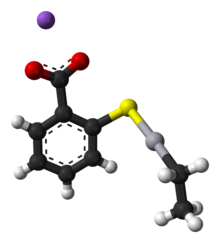
Back ثيوميرسال Arabic تیومرسال AZB Thiomersal Czech Thiomersal German Tiomersal Spanish تیومرسال Persian Tiomersaali Finnish Thiomersal French Thimerosal Italian チメロサール Japanese

| |

| |
| Names | |
|---|---|
| IUPAC name
Ethyl(2-mercaptobenzoato-(2-)-O,S) mercurate(1-) sodium
| |
| Other names
Mercury((o-carboxyphenyl)thio)ethyl sodium salt, sodium ethylmercurithiosalicylate
| |
| Identifiers | |
3D model (JSmol)
|
|
| 8169555 | |
| ChEBI | |
| ChEMBL | |
| ChemSpider | |
| DrugBank | |
| ECHA InfoCard | 100.000.192 |
| EC Number |
|
| 1677155 | |
| KEGG | |
PubChem CID
|
|
| RTECS number |
|
| UNII | |
CompTox Dashboard (EPA)
|
|
| |
| |
| Properties | |
| C9H9HgNaO2S | |
| Molar mass | 404.81 g/mol |
| Appearance | White or slightly yellow powder |
| Density | 2.508 g/cm3[1] |
| Melting point | 232 to 233 °C (450 to 451 °F; 505 to 506 K) (decomposition) |
| 1000 g/L (20 °C) | |
| Pharmacology | |
| D08AK06 (WHO) | |
| Hazards | |
| GHS labelling: | |
  
| |
| Danger | |
| H300, H310, H330, H373, H410 | |
| P260, P273, P280, P301, P302, P304, P310, P330, P340, P352[2] | |
| NFPA 704 (fire diamond) | |
| Flash point | 250 °C (482 °F; 523 K) |
| Lethal dose or concentration (LD, LC): | |
LD50 (median dose)
|
75 mg/kg (oral, rat)[3] |
| Safety data sheet (SDS) | External MSDS |
Except where otherwise noted, data are given for materials in their standard state (at 25 °C [77 °F], 100 kPa).
| |
Thiomersal (INN), or thimerosal (USAN, JAN), also sold under the name merthiolate[4] is an organomercury compound. It is a well-established antiseptic and antifungal agent.[5]
The pharmaceutical corporation Eli Lilly and Company named it Merthiolate. It has been used as a preservative in vaccines, immunoglobulin preparations, skin test antigens, antivenins, ophthalmic and nasal products, and tattoo inks.[6] In spite of the scientific consensus that fears about its safety are unsubstantiated,[7][8][9][10] its use as a vaccine preservative has been called into question by anti-vaccination groups. A 1999 statement issued in CDC's Morbidity and Mortality Weekly Report announced that "the Public Health Service (PHS), the American Academy of Pediatrics (AAP), and vaccine manufacturers agree that thimerosal-containing vaccines should be removed as soon as possible" and that these groups would collaborate to replace them while manufacturers committed "to eliminate or reduce as expeditiously as possible the mercury content of their vaccines."[11][12][13] It remains in use as a preservative for certain annual flu vaccines, mostly those stored in multi-dose vials.[14][15]
- ^ Cite error: The named reference
molstructwas invoked but never defined (see the help page). - ^ "Thimerosal T5125".
- ^ Chambers, Michael. "ChemIDplus – 54-64-8 – RTKIYNMVFMVABJ-UHFFFAOYSA-L – Thimerosal [USP:JAN] – Similar structures search, synonyms, formulas, resource links, and other chemical information". chem.sis.nlm.nih.gov. Retrieved 3 April 2018.
- ^ "Merthiolate poisoning: MedlinePlus Medical Encyclopedia". medlineplus.gov. Retrieved 8 December 2023.
- ^ "Thimerosal and Vaccines | Vaccine Safety | CDC". Centers for Disease Control and Prevention. 25 August 2020. Retrieved 4 May 2023.
- ^ Sharpe, M. A.; Livingston, A. D.; Baskin, D. S. (2012). "Thimerosal-Derived Ethylmercury is a Mitochondrial Toxin in Human Astrocytes: Possible Role of Fenton Chemistry in the Oxidation and Breakage of mtDNA". Journal of Toxicology. 2012: 1–12. doi:10.1155/2012/373678. PMC 3395253. PMID 22811707.
...widely used in medical products, including as a preservative in vaccines, immunoglobulin preparations, skin test antigens, antivenins, ophthalmic and nasal products, and tattoo inks...
- ^ Immunization Safety Review Committee, Board on Health Promotion and Disease Prevention, Institute of Medicine (2004). Immunization Safety Review: Vaccines and Autism. Washington, DC: The National Academies Press. ISBN 978-0-309-09237-1.
{{cite book}}: CS1 maint: multiple names: authors list (link) - ^ Doja, Asif; Roberts, Wendy (November 2006). "Immunizations and autism: a review of the literature". Can J Neurol Sci. 33 (4): 341–46. doi:10.1017/s031716710000528x. PMID 17168158.
- ^ "Vaccines Do Not Cause Autism". cdc.gov. Retrieved 29 November 2015.
- ^ Gołoś, A; Lutyńska, A (2015). "Thiomersal-containing vaccines - a review of the current state of knowledge". Przeglad Epidemiologiczny. 69 (1): 59–64, 157–61. PMID 25862449.
- ^ "Thimerosal in Vaccines: A Joint Statement of the American Academy of Pediatrics and the Public Health Service" (PDF). Morbidity and Mortality Weekly Report Vol. 48 No. 26. Centers for Disease Control and Prevention. 9 July 1999. pp. 563–65. Retrieved 8 May 2024.
- ^ Hurley, A; Tadrous, M; Miller, E (July–September 2010). "Thimerosal-Containing Vaccines and Autism: A Review of Recent Epidemiologic Studies". J Pediatr Pharmacol Ther. 15 (3): 173–181. PMC 3018252. PMID 22477809.
- ^ Cite error: The named reference
drugsafwas invoked but never defined (see the help page). - ^ "Not Immune". The New Yorker. 8 February 2015. Retrieved 2 October 2022.
- ^ https://www.cdc.gov/flu/prevent/thimerosal.htm
© MMXXIII Rich X Search. We shall prevail. All rights reserved. Rich X Search
